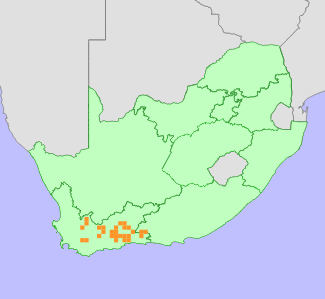|
Scientific Name | Conophytum truncatum (Thunb.) N.E.Br. subsp. truncatum |
Higher Classification | Dicotyledons |
Family | AIZOACEAE |
National Status |
Status and Criteria | Endangered A3c |
Assessment Date | 2023/10/30 |
Assessor(s) | A.J. Young, P.G. Desmet, I. Ebrahim, D. Guo, A. Harrower, L. Jabar, L. Knoetze, C. Rodgerson, P.C.V. Van Wyk & N.N. Mhlongo |
Justification | This succulent is endemic to the Western Cape of South Africa with an extent of occurrence (EOO) of 30,426 km2 and area of occupancy (AOO) of 140 km2. Anthropogenic climate change is a major threat to this taxon. Whilst climate models predict a near-complete loss of 99% of suitable bioclimatic habitat by 2080 under likely emission scenario RCP 2.6, this taxon is widespread across numerous vegetation units and is expected to show a level of resilience to climate change. Thus while model predictions place this species in the category Critically Endangered under criterion A3, the expected population reduction is decreased by 20% to 79%. It therefore qualifies as Endangered under criterion A3. |
Distribution |
Endemism | South African endemic |
Provincial distribution | Eastern Cape, Western Cape |
Range | This taxon is endemic to the Western Cape of South Africa. |
Habitat and Ecology |
Major system | Terrestrial |
Major habitats | Albany Thicket, Fynbos, Nama Karoo, Succulent Karoo |
Description | This succulent is primarily found in the Succulent Karoo biome but is also present in the Fynbos biome; Rainshadow Valley Karoo and Sandstone Fynbos bioregions. The plants occupy a broad range of habitats including sun-exposed areas but are more commonly in part-shade under larger shrubs, on ridges and cliff faces.
This taxon has a generation length of 30 years. It is expected to be sensitive to the impacts of climate change as it does not disperse and while adapted to arid conditions, is dependent on limited seasonal rainfall. Species in the genus are sensitive to long periods of drought. Drought related mortality has been observed for other closely related taxa within the genus. |
Threats |
| This taxon is experiencing initial levels of decline due to illegal collection for the international trade in ornamental succulents. This is likely to increase in future as there has been a dramatic increase in the number of species and volume of plants targeted since 2019 but the distribution across numerous localities and the large population size is likely to restrict the decline to no more than 25% over the next three generations (90 years).
There is no decline in habitat quality for this taxon as inferred by changes in vegetation cover determined from changes in Enhanced Vegetation Index (EVI) between 1984 and 2018 using Landsat data (Venter et al. 2020). Anthropogenic climate change is a long-term threat to this succulent. Climate models for the likely emission scenarios where emissions stay at present day levels (RCP 2.6) (Hausfather and Peters 2020) and worst case scenarios where emissions continue to increase during the 21st century (RCP 8.5) indicate that there will be a loss of suitable bioclimatic envelope of between 99% and 100% by 2080 for this taxon. However, as this taxon occurs across several vegetation units it is expected to have a level of resilience to climate change and the expected population loss is reduced by 20% to 79%. Species in this genus have limited dispersal ability and migration to suitable habitats elsewhere is regarded as highly unlikely. |
Population |
This dwarf succulent is often locally abundant across numerous subpopulations each of which may contain hundreds or thousands of plants. The population size is likely to be well in excess of 500,000 mature individuals. The population is experiencing initial levels of decline due to illegal collection for the ornamental succulent plant trade.
|
Population trend | Decreasing |
Assessment History |
Taxon assessed |
Status and Criteria |
Citation/Red List version | | Conophytum truncatum (Thunb.) N.E.Br. subsp. truncatum var. truncatum | Least Concern | Raimondo et al. (2009) | | Conophytum truncatum (Thunb.) N.E.Br. subsp. truncatum var. wiggettiae (N.E.Br.) Rawé | Least Concern | Raimondo et al. (2009) | |
Bibliography |
Hammer, S. 2002. Dumpling and his wife: New view of the genus Conophytum. EAE Creative Colour, Norwich.
Hammer, S.A. 1993. The genus Conophytum: A conograph. Succulent Plant Publications, Pretoria.
Hausfather, Z. and Peters, G.P. 2020. Emissions - the 'business as usual' story is misleading. Nature 577(618-620).
Opel, M.R. 2004. The rediscovery of Crassula alcicornis. Haseltonia 10:38-40.
Raimondo, D., von Staden, L., Foden, W., Victor, J.E., Helme, N.A., Turner, R.C., Kamundi, D.A. and Manyama, P.A. 2009. Red List of South African Plants. Strelitzia 25. South African National Biodiversity Institute, Pretoria.
|
Citation |
| Young, A.J., Desmet, P.G., Ebrahim, I., Guo, D., Harrower, A., Jabar, L., Knoetze, L., Rodgerson, C., Van Wyk, P.C.V. & Mhlongo, N.N. 2023. Conophytum truncatum (Thunb.) N.E.Br. subsp. truncatum. National Assessment: Red List of South African Plants version 2024.1. Accessed on 2025/12/23 |
 Comment on this assessment
Comment on this assessment


